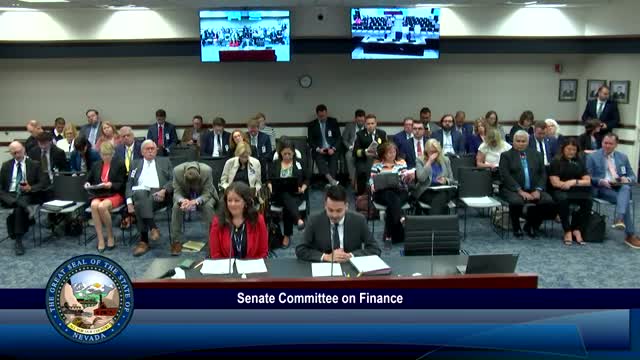Nevada Senate Bill 423 aims to secure sustainable public health funding through insurance premium tax
May 21, 2025 | 2025 Legislature NV, Nevada
This article was created by AI summarizing key points discussed. AI makes mistakes, so for full details and context, please refer to the video of the full meeting. Please report any errors so we can fix them. Report an error »

In a pivotal meeting of the Nevada State Legislature's Senate Committee on Finance, lawmakers gathered to discuss Senate Bill 423, a proposed measure aimed at bolstering the state's public health infrastructure amid significant federal funding cuts. The atmosphere was charged with urgency as committee members examined the implications of nearly $100 million in lost federal grants, which have severely impacted public health services across Nevada.
The bill, introduced by Amy Hein Sutherland, seeks to create a sustainable funding mechanism for local public health initiatives. With the backdrop of recent layoffs and halted strategic development due to funding shortages, the proposed legislation aims to allocate $4.9 million over the next biennium, starting in 2027. This investment is intended to provide each county with $225,000 per biennium, ensuring that foundational public health services are accessible to all communities, particularly in rural and underserved areas.
Senator Cannizzaro raised critical questions about the funding source, noting that the bill relies on the insurance premium tax, which is a significant revenue stream for the state. While acknowledging the necessity for reliable funding, he expressed concerns about the implications of diverting general fund dollars for this purpose. The discussion highlighted the delicate balance between immediate funding needs and the long-term sustainability of public health programs.
The committee members engaged in a robust dialogue about the fiscal responsibility of using existing general fund revenues versus seeking new revenue sources. Some lawmakers suggested exploring alternative funding mechanisms, such as a provider tax, to enhance public health financing without compromising other state services.
As the meeting concluded, the urgency of addressing Nevada's public health challenges was palpable. With the potential for further federal cuts looming, the committee's deliberations on Senate Bill 423 could shape the future of public health in the state. The outcome of this legislation will not only determine funding levels but also reflect the state's commitment to safeguarding the health of its residents in an increasingly uncertain financial landscape.
The bill, introduced by Amy Hein Sutherland, seeks to create a sustainable funding mechanism for local public health initiatives. With the backdrop of recent layoffs and halted strategic development due to funding shortages, the proposed legislation aims to allocate $4.9 million over the next biennium, starting in 2027. This investment is intended to provide each county with $225,000 per biennium, ensuring that foundational public health services are accessible to all communities, particularly in rural and underserved areas.
Senator Cannizzaro raised critical questions about the funding source, noting that the bill relies on the insurance premium tax, which is a significant revenue stream for the state. While acknowledging the necessity for reliable funding, he expressed concerns about the implications of diverting general fund dollars for this purpose. The discussion highlighted the delicate balance between immediate funding needs and the long-term sustainability of public health programs.
The committee members engaged in a robust dialogue about the fiscal responsibility of using existing general fund revenues versus seeking new revenue sources. Some lawmakers suggested exploring alternative funding mechanisms, such as a provider tax, to enhance public health financing without compromising other state services.
As the meeting concluded, the urgency of addressing Nevada's public health challenges was palpable. With the potential for further federal cuts looming, the committee's deliberations on Senate Bill 423 could shape the future of public health in the state. The outcome of this legislation will not only determine funding levels but also reflect the state's commitment to safeguarding the health of its residents in an increasingly uncertain financial landscape.
View full meeting
This article is based on a recent meeting—watch the full video and explore the complete transcript for deeper insights into the discussion.
View full meeting